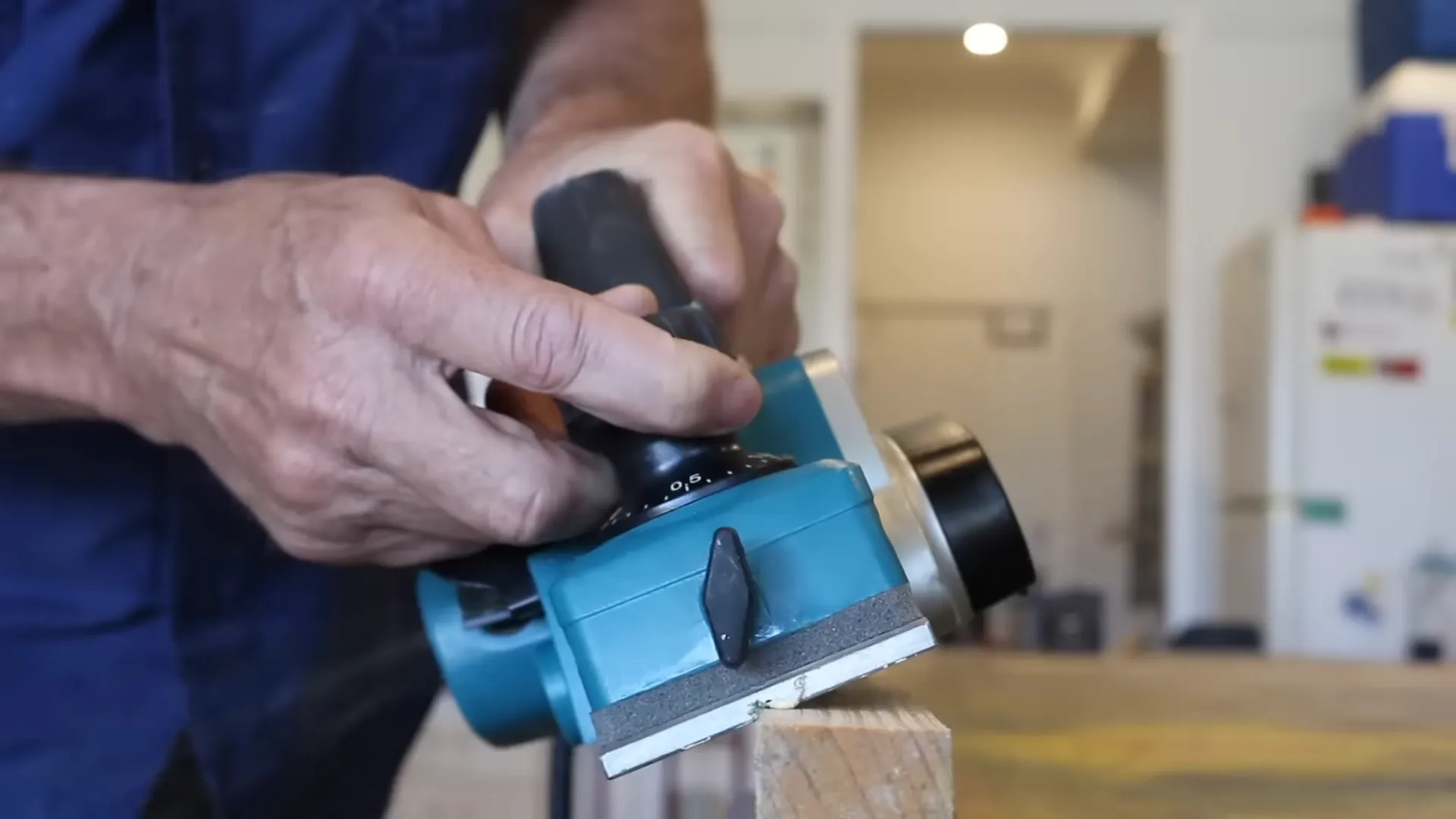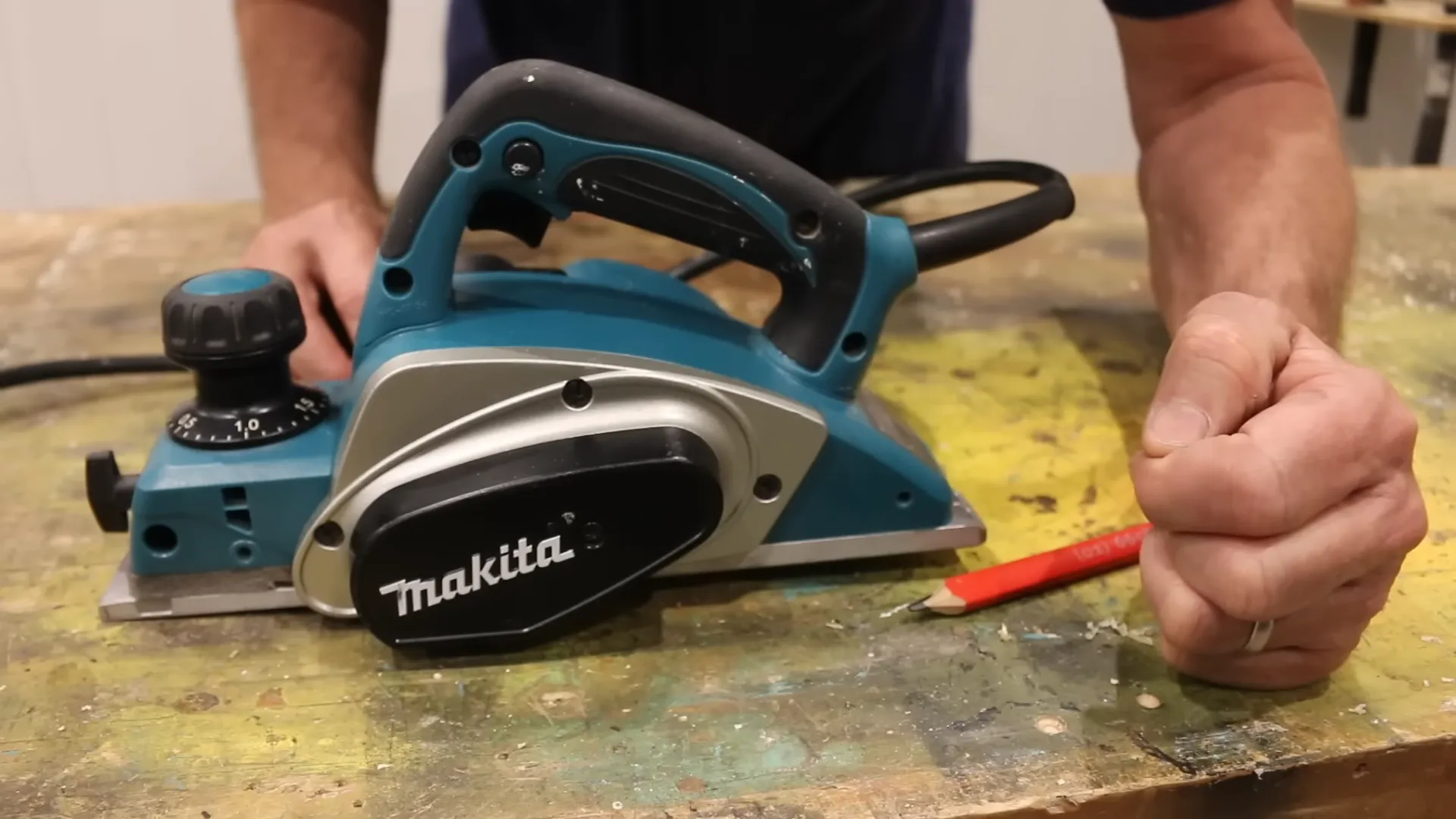11 Common Electric Planer Problems [Easy Fixes!]
Electric planers are super handy tools for smoothing and flattening wood surfaces. But like any power tool, they can develop issues that affect performance.
We’ll walk through the 11 most common electric planer problems DIYers and woodworkers face, along with tips on how to diagnose and fix them.
With a bit of troubleshooting and maintenance, you can keep your planer running smoothly for years.
Let’s get started!
1. The Dreaded Snipe
You’ve finished planing a beautiful board, flip it over, and… gouge city. The ends are chiseled down with ugly snipe marks. This is one of the most irritating electric planer problems.
What Causes Snipe?
Snipe happens when the board isn’t properly supported as it enters and exits the planer. The cutterhead takes a bigger bite at the end and gouges into the wood.
Some common culprits behind snipe:
- Worn or misaligned infeed/outfeed rollers. If they don’t support the board, it can dip as it enters/exits.
- Blunt, chipped, or incorrectly set planer knife. This forces the cutterhead to take bigger bites instead of smooth cuts.
- Feeding the board too fast. If you rush it through the planer, the ends won’t be supported properly.
Snipe Fixes
- Support the board with auxiliary tables at the infeed and outfeed sides. This keeps the ends level.
- Adjust the roller height so they make flush contact with the workpiece.
- Sharpen or replace a dull planer knife. Keep those edges sharp!
- Adjust the planer knife to the ideal height setting.
- Feed the board slowly and smoothly. No rushing! This gives the best cut.
2. Annoying Chip Marks
You finally have a smooth surface, but it’s marred with little dimples and nicks. It’s like wood chip acne!
What Causes Chip Marks?
As the name suggests, chip marks happen when small wood chips get stuck under the planer cutterhead. As they pass under the spinning knife, they dig into the wood, leaving tiny grooves.
This tends to happen when:
- The planer knife is dull and doesn’t cut cleanly.
- Chip buildup under the planer shoe or cutterhead isn’t cleaned out regularly.
- Feeding the wood too slowly. This gives chips time to catch on the cutterhead surface.
Eliminating Chip Marks
- Sharpen or replace that dull planer knife! Sharp edges are key.
- Clear any chip gunk from under the cutterhead shoe and around the rollers.
- Maintain a steady feed rate so chips exit quickly.
3. Super Annoying Tear Out
You’re cruising along planing a board when suddenly…splinters everywhere! Ugly little trenches are torn out of the wood surface. Not a good look.
What Causes Tear Out?
Tear out happens when the spinning planer knife rips up fragile splinters instead of cutting cleanly. It’s common in woods with:
- Knots, burls and dramatic grain changes. These dense areas crumble when cut.
- A blunt, chipped, or improperly set planer knife tears instead of cutting.
- Cutting against the wood grain. This fractures the fibers instead of slicing smoothly.
Fix Tear Out With:
- Avoid super knotty and burl-filled boards if possible. Straight grain is best.
- Sharpen and set the knife properly. A fresh, sharp edge cuts cleanly.
- When possible, feed with the grain to reduce splintering.
- Take very light finishing passes on problem woods.
- Apply masking tape over gnarly grain before planing to reduce splintering.
4. Pesky Chatter Marks
You finish planing and notice weird rippled ridges across the wood surface. The texture is rough and uneven. Not an ideal look.
What Causes Chatter Marks?
Chatter marks happen when the spinning planer knife vibrates during cutting. This leaves closely spaced ripple-like ridges.
Some potential causes:
- A dull knife that needs sharpening causes extra vibration.
- Taking too heavy of a cutting pass for the wood type.
- Incorrectly installed cutterhead allows too much vibration and chatter.
Smoothing Out Chatter Marks
- Sharpen those knives or take lighter passes. Fresh sharp edges help!
- Make sure the cutterhead is balanced and securely installed.
- Tighten any loose bolts around the cutterhead assembly.
- Take lighter passes on delicate woods to reduce vibration.
5. Ugly Black Burn Marks
You’re buzzing along planning a board when suddenly dark, blackish streaks appear along the wood surface. Not exactly an ideal finish.
What Causes Burning?
Burn marks happen when too much friction builds up between the wood and the planer knife. The heat singes the wood fibers.
Some potential causes:
- Feeding the wood too slowly. This increased friction and allows burning.
- Taking too deep of a cut. Deeper cuts = more heat.
- A dull planer knife also increases friction and burning.
Avoiding Burn Marks
- Speed up the wood feed rate to reduce friction.
- Take shallower passes to remove less material.
- Sharpen or replace any dull knives. Sharp = less friction.
- Clean off any sticky resin buildup on planer parts.
6. Aggravating Crooked Cuts
You finish planing and one side is noticeably thinner. The board is now tapered or warped. Not the nice flat surface you wanted!
What Causes Crooked Cuts?
Crooked cuts happen when the planer removes more material on one side. This can be caused by:
- The outfeed table is set higher/lower than the infeed side.
- Uneven pressure pushing the board through crooked.
- A misaligned cutterhead removes more from one side.
- Debris under the planer shoe causes uneven cutting depth.
Fixing Crooked Cuts
- Level the infeed and outfeed tables so they match.
- Focus on feeding gently and smoothly. Don’t skew the board.
- Realign the cutterhead so it cuts evenly.
- Clean under the shoe to remove any debris.
7. Super Fuzzy Grain
You finish planing and some wood types get a weird fuzzy, hairy texture. It’s like planing a fuzzy caterpillar! Not the silky finish you wanted.
What Causes Fuzzy Grain?
Some wood species like oak and elm just have naturally fuzzy grain that fuzzes up when cut. Also:
- A dull planer knife tears and lifts the grain instead of slicing cleanly.
Dealing with Fuzzy Grain
- It’s natural for some woods like oak. Don’t consider it a defect.
- Use sharp planer knives and replace dull ones. Sharp cutting minimizes fuzz.
- Make very light finishing passes on fuzzy-grained woods.
- Masking tape can minimize fuzzing on problem woods.
8. Inconsistent Board Thickness
You finish planing and different spots on the board are thicker/thinner. The surfaces are no longer parallel. Yuck!
What Causes Thickness Variation?
Uneven thickness happens when the planed cut depth varies at different spots:
- The infeed/outfeed tables aren’t level. This tilts the board.
- One cutterhead side is set deeper than the other.
- Worn rollers allow the board to dip unevenly.
Smoothing Out Thickness Variation
- Level the infeed and outfeed tables to match.
- Adjust the cutterhead height evenly on both sides.
- Replace any worn or deformed feed rollers.
9. Sudden Cutterhead Stoppage
You’re planing away when the cutterhead suddenly grinds to a halt. Well that’s not ideal!
Why Did the Cutterhead Stop?
There’s a few potential culprits if the cutterhead suddenly stops spinning:
- Power loss to the planer itself.
- A broken or jammed v-belt.
- Faulty motor.
- Loose drive pulley set screw.
- Obstruction hitting the cutterhead.
Getting it Spinning Again
- Check for tripped breaker or unplugged cord.
- Inspect, retension or replace any damaged v-belt.
- Test and replace a bad motor.
- Re-tighten any loose pulley set screws.
- Carefully inspect and remove any debris hitting the cutterhead.
10. Loud Noise and Vibration
You power up your planer and it starts making awful noises, shaking and excessive vibrating. Yikes!
Why All the Noise and Vibration?
Potential sources include:
- Damaged cutterhead, loose or broken knives.
- A bent planer shaft.
- Loose components like mounts, bolts, bearings, etc.
Smoothing it Out
- Inspect the cutterhead for damage and tighten/replace any loose knives.
- Check the shaft for bends and get it realigned if needed.
- Go through the planer and tighten any loose components.
- Replace any damaged mounts, bolts, bearings contributing to vibration.
11. Frustrating Wood Feeding Issues
You go to plane a board but the feed rollers just spin and slip. The board won’t feed through the planer!
Why Won’t it Feed Wood Properly?
Some potential causes of wood feeding problems:
- The rollers are worn smooth and don’t grip the workpiece.
- Chip buildup on the rollers reduces traction.
- The feed speed is set faster than the rollers can properly grip.
Improving Wood Feeding
- Clean rollers with solvent/degreaser to remove slippery buildup.
- Replace worn rollers to renew the grip texture.
- Reduce the feed speed to an appropriate rate for grip.
Keep Your Planer Running Smoothly
While electric planers are super handy woodworking tools, they can definitely run into problems that affect cutting quality and performance.
Follow this guide when troubleshooting your planer. With a bit of maintenance and TLC, you can have it running like new in no time.
The key things to watch for are dull/damaged knives, proper feed speed and workpiece support, clearing away debris, and general cleanup/tightening of components. Catch problems early before they turn into bigger issues.
And don’t be afraid to call in a qualified technician for repairs if something goes haywire with your electric planer. They have the expertise to get it tuned up and humming smoothly again.
With just a bit of care, your faithful electric planer can continue chewing through piles of lumber and turning rough surfaces glassy smooth for years to come!



